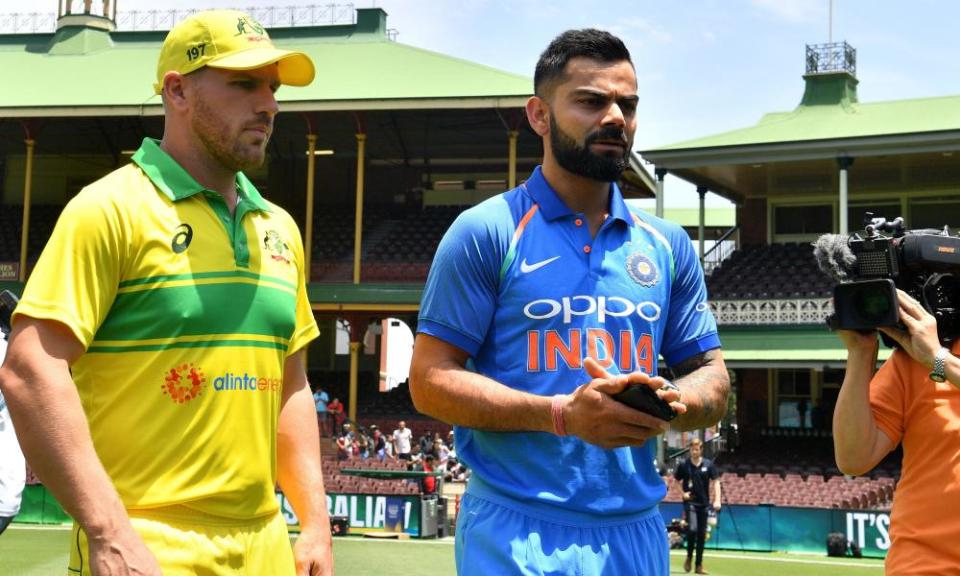India creep into Australia but Virat Kohli's cricket team will not be intimidated

In a way, the India-Australia summer about to start has snuck up on us. The visiting players arrived from quarantine in Dubai to be whisked away to quarantine in Sydney. They have been training alone in a cordoned-off stadium that is already a long way from the bright lights out in Blacktown, a ground on a patch of bushland squashed between a freeway and a creek, with no company bar a couple of obsessive journalists crawling around in the bushes near the perimeter fence to report on movements inside the wire.
But this Friday, that team dressed in retro dark blue will emerge from behind the fences and the masks to appear on the Sydney Cricket Ground, led out by captain Virat Kohli, even playing in front of a live crowd after all the canned foley of recent months in empty monoliths.
Related: The redemption myth: sporting comebacks are as predictable as they are overblown | Geoff Lemon
The start has also approached quietly because we are about to have the smash-and-grab games, the one-dayers and the Twenty20s, rather than the imposing juggernaut of a Test match rounding the headland into view. But as soon as those shorter matches start, we’ll remember that they mean something too.
In another sense, the summer will keep approaching quietly for some because those opening games are all quarantined on pay television, another legacy of the disastrous broadcast deal that Cricket Australia signed in 2018. The legacy belongs equally to a complicit communications minister as part of a weak federal government that allowed the deal to proceed when it should have been blocked under Australia’s anti-siphoning laws regarding national teams on free-to-air television.
Those with enough money to subscribe, then, get to anticipate the limited-overs games before a Test series against the same opponent. One of the lost benefits of summers past was that one-dayers would be a lead-in, a palate teaser, a gradual heightening of the stakes. More recently we would instead start the season cold, straight into a Test match in Hobart in early November on a morning when snow still dusted Mount Wellington. That match would be almost indigestible, congealed. Once we had worked our way into and through the whole series, the short games that followed seemed random and pointless, garbage islands floating around the shipping lanes of the Big Bash.
This year the Australian pyjama games will be over before the Bash begins, with the domestic fluorescent fairy-floss competition instead running while India’s Test squad play their preparation matches. Aside from the day-night Test in Adelaide, the Bash will comfortably coexist as the evening crash-bang to follow the stately pace of a long-form day.
As we prepare to start, there is a sense that the viewing public and the media in Australia both have to get the most out of Kohli from the white-ball matches and the one Test he will be able to play before he returns home for the birth of his first child. Kohli too knows that he has only a limited time on the stage. He is such an intense scorer of runs that a condensed hit of him could be dangerous.
It is fascinating how much Kohli has captured the attention of Australian broadcasters. Between Rupert Murdoch’s Foxtel and Murdoch’s newspapers, cricket gets saturation promotional coverage in a way it never used to do. But the selling point, the motif, is Kohli. Up he pops on your screen during other events, a little finger-puppet image cut off at the waist, arms crossed. His name is all over the paper. He’s in the nets, smoking them, a threat incoming. Australia are not playing India, Australia are playing Kohli. Even when he is gone, the summer will be defined by his absence. Where visiting players used to get scant mention except as a canvas for Australian wins, now one at least is everywhere, a visual shorthand for sales.
Related: Steve Smith 'finds hands' in ominous sign ahead of Australia's first ODI against India
But beyond Kohli will be a short-form team honed by the recent IPL. Mayank Agarwal, Shreyas Iyer, KL Rahul, Hardik Pandya, all ready to let fly with the bat. Jasprit Bumrah and Mohammed Shami with the ball. These Indian players are no longer intimidated by coming to Australia like generations past might have been. They play in more intense settings for a couple of months every year.
As for Australia, there is the relief of things being a kind of normal. The batting old firm of Aaron Finch, David Warner, Steve Smith and Glenn Maxwell, the bowling old firm of Mitchell Starc, Patrick Cummins, Josh Hazlewood and Adam Zampa. The rising star of Marnus Labuschagne, familiar all-rounders in Ashton Agar and Marcus Stoinis along with the new excitement of Cameron Green, the wicketkeeping finishers in Alex Carey and Matthew Wade.
This is a quality bunch of players who have been short of national action for a long time. When they roll out once again, we will get to remember what it is like to watch the cricket in an Australian summer. Some part of the grime and grimness of this year may for a time feel washed away.

 Yahoo Finance
Yahoo Finance 